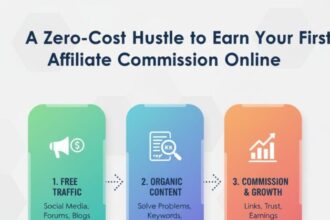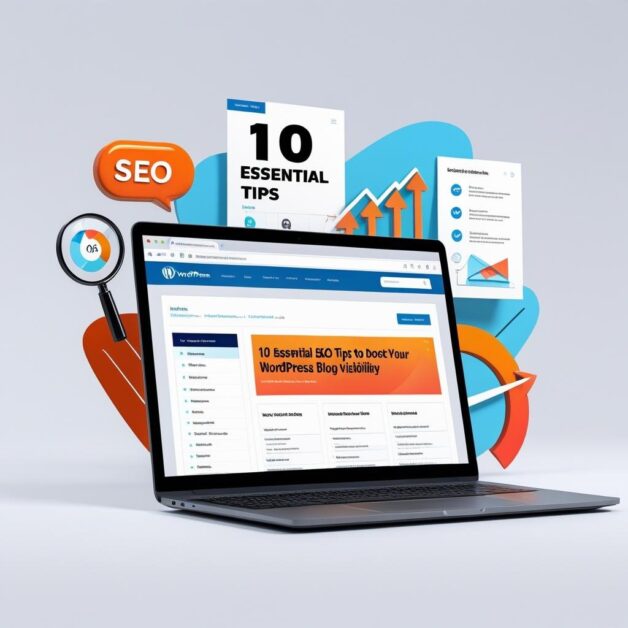A Casual Guide to Transforming a Single Blog Post into a Podcast Episode, Social Media Content, and an Email Newsletter
I remember sitting there, staring at the screen. The word count was just over 1,500. It was the best blog post I’d ever written, or so I thought. And I’d been writing for weeks. Every single word was a struggle. It was about something deeply personal. I’d poured my heart and soul into it.
So, you can imagine my dilemma. I hit “publish.” And… nothing.
Well, not nothing. A few people liked it. A couple of folks left a comment. But it felt so anticlimactic. Like yelling into a void. I had all this raw material. So much passion. And it just sat there, a lonely lighthouse in the digital fog.
Have you ever felt that? That feeling that your best work is being wasted? It’s a real punch to the gut. I was ready to give up. I thought, what’s the point?
But then an idea hit me. Maybe the problem wasn’t the content itself. Maybe the problem was that it was only living in one place. One tiny corner of the internet.
So I started thinking. Could this one blog post become something more? Something bigger? Could it reach people who don’t even read blogs? And that’s when I started to figure out a step-by-step guide to transforming a single blog post into a podcast episode, social media content, and an email newsletter. It feels a little bit like magic, but it’s really just a smart workflow.
The Confusing Part of Content Repurposing
Honestly, when I first started looking into this whole idea, it was overwhelming. I typed “content repurposing strategy” into the search bar, and what came back was a wall of corporate speak. Jargon about “synergistic cross-platform leverage” and “omnichannel audience acquisition.” I have no idea what half of that stuff even means. It’s just my take, but it feels like the people who write those guides want you to believe this is a big, complex, and unapproachable thing.
And so I got a little stuck. It felt like I was trying to build a rocket ship when all I needed was a bicycle.
So I decided to ignore all the fancy words. I focused on the core idea. Basically, what if your one big blog post was like a big pile of Legos? You can build one awesome castle with it. But you could also break it down and use those same bricks to build a bunch of smaller, cooler things, right? Maybe a little car. Or a tiny robot. Or a neat house.
In this way, your blog post is the pile of bricks. The podcast is the castle. The social media posts are the little cars and robots. The email newsletter is the neat house. It’s all the same original material, just reshaped and re-imagined. And that, in a nutshell, is the foundation of a real-world content repurposing strategy. It’s not magic. It’s just a different way of looking at what you’ve already created.
Getting Started with Transcribing
So, where do you begin? I think you have to start with the source. Your blog post. And for me, that meant getting it ready for the next phase. So, the first step is surprisingly simple. You need to read your post out loud.
Yes, really. Grab a cup of coffee. Go to a quiet room. And just read it. Why? Because the way we write and the way we speak are different. I noticed right away that some of my long, elegant sentences sounded clunky when spoken. So I changed them. I broke them up. I added some more conversational phrases.
After that, you need to think about turning your text into audio. There are a few ways to do this. You could use an AI tool to read it for you, but honestly, from what I can tell, it still sounds a little robotic. It lacks the human touch. The pauses. The laughter. The sighs.
I decided to just record myself reading the post. I used my phone and a simple microphone. It wasn’t perfect. I stumbled over words. I coughed. But those little mistakes made it feel more real. And, ultimately, that’s what a good podcast is all about. It’s a conversation. It’s not a perfectly polished lecture. It’s just me, talking to you. It’s just a person, sharing their thoughts.
From Blog Post to Podcast Script
Once you have your blog post ready, you can start building the podcast. But don’t just read the entire article word-for-word. That’s boring. Trust me. I tried.
Think of your article as a script outline. It’s got the main points already laid out. It has the structure. What you need to do now is add the personality. Add the “umms” and “aahs.” Add the stories.
For example, I had a section in my blog post about a moment of failure. In the article, it was just a few sentences. But for the podcast, I expanded on it. I told the full story. I talked about how I felt. I laughed at myself. This extra detail is what makes a podcast feel personal and engaging. This is where you can really bring your voice to life. It’s about taking the essence of your writing and adding the sound of your personality.
Another thing I discovered is that you need to add an intro and an outro. The intro sets the stage. It tells people what the episode is about and why they should listen. And the outro is your chance to connect with your audience. To ask them to subscribe. To tell them where to find you next.
Ultimately, your blog post is the skeleton. The podcast is the body and the soul. And what’s really amazing is that the act of creating the podcast, of speaking the words, actually helped me clarify my own thinking about the topic. It was a form of reflection. And it felt like a discovery.
Crafting the Perfect Episode
Creating a good podcast episode is more than just reading your blog post into a microphone. It’s about making it listenable. You have to think about the flow. You have to think about the energy.
It’s a lot like a conversation. You don’t want to ramble on and on. You need to keep things moving. I found it helpful to break my blog post into small, digestible chunks. I’d read a section, pause, and then maybe add a spontaneous thought or a personal anecdote.
You can also use music to set the mood. I picked some upbeat, friendly music for my intro and outro. I even found some subtle background music to play during a few sections of my podcast. It helps create a certain atmosphere. It makes the content feel more professional. And it just keeps the listener engaged.
Now, you might think you need a fancy studio to do this. And from what I can tell, that’s just not the case. I use a simple microphone and a free audio editing software called Audacity. I learned a few simple tricks, like how to cut out my coughs and how to add the intro music. It wasn’t hard at all.
This is a great chance to think about what your audience would want to hear. Are there questions you can ask them to get them thinking? Are there parts of your article that would benefit from more explanation? It’s really about taking your words off the page and making them come alive through sound. And for me, that was a real game-changer.
The Art of Multi-Channel Content Creation
Okay, so we’ve got the blog post and the podcast. Now what? This is where the real power of a multi-channel content creation strategy comes in. You’ve already done most of the heavy lifting. All the research and writing is done. So why not use that material to reach people on other platforms?
This is where you start to break down your big idea into smaller, more manageable pieces. Think of it like a puzzle. You have the full picture, which is your blog post. Now you’re going to take some of the most interesting pieces and share them on different platforms.
So, how do you do that? You look for the little nuggets of wisdom. The short, punchy quotes. The surprising statistics. The personal anecdotes.
For example, my blog post had a statistic about how many people feel isolated in their work. That’s a perfect social media post. It’s a question you can ask people. “Did you know that 70% of remote workers feel lonely? Have you ever felt that way?” That’s a great way to start a conversation. It’s not a wall of text. It’s a simple, engaging prompt.
I started a little spreadsheet to keep track of these things. I’d go through my blog post and highlight the best quotes, the key takeaways, and the most compelling questions. It’s like a treasure hunt. And it turns your single piece of content into a whole content calendar. It’s just a more efficient way to work.
Creating Social Media Snippets
So, you have these little nuggets of wisdom. How do you turn them into actual social media snippets? The first thing to remember is that every platform is different. A good Facebook post isn’t the same as a good Instagram post. And they’re both different from a great LinkedIn post.
For Facebook, you can use a short quote or a question from your article. You can add a personal photo or a relevant image. You should also make sure to link back to your blog post and podcast.
For Instagram, you might create a short, visually appealing graphic with a quote from your article. You could use an app like Canva to make it look professional. And then, in the caption, you can write a little story that relates to the quote. You can tell people that they can find the full story by clicking the link in your bio.
And for LinkedIn? That’s a great place to share the professional lessons you learned from your experience. You can talk about the process of writing the article. You can share your tips for being more productive. It’s all about sharing a different side of the same story.
Basically, you’re just taking the same information and repackaging it. It’s like a different outfit for a different party. Same person, different look. And it’s a brilliant way to save time and energy. It’s a way to ensure your hard work gets seen by the right people, no matter where they hang out online.
The Power of an Email Newsletter Adaptation
So, you’ve got your blog post. Your podcast. Your social media posts. Now what? Now it’s time to talk about the newsletter. And I think this is where you can build the deepest connection with your audience. Because when someone gives you their email, it’s a sign of trust.
This is also a great place to showcase your email newsletter adaptation skills. It’s not just about copying and pasting your blog post into an email. That’s a fast way to get people to unsubscribe. Why? Because most people don’t want to read a long-form article in their inbox. It’s just not how people consume email.
So, what should you do instead? You should think of your newsletter as a teaser. A warm invitation. You should write a short, personal introduction. Talk about why you wrote the article in the first place. Tell a little story that didn’t make it into the final draft of the post.
Then, you can share a few key takeaways or the main points. You can even use bullet points. Make it easy to read. Make it easy to scan. And at the end, you should have a clear call to action. You should invite people to click a link to read the rest of the post on your blog. Or listen to the full podcast episode.
So it’s not just a newsletter. It’s a bridge. It connects your audience directly to your best work. And from what I can tell, it’s one of the most effective ways to build a loyal following. It’s all about providing value and building a relationship. It’s not about being a salesperson.
The Secret Sauce of Audience Engagement Across Platforms
Ultimately, the goal of all this isn’t just to make more stuff. It’s to build a relationship. It’s to foster audience engagement across platforms. It’s about being present and being helpful. It’s about answering questions and starting conversations.
So, when someone leaves a comment on your blog post, reply to them. When someone asks a question on social media, answer it. When someone replies to your email newsletter, respond. This is how you build a community. This is how you let people know that you actually care.
And you might think, “That’s a lot of work.” And it is, I won’t lie. But it’s also the most rewarding part of the process. Because when you’re creating content, you’re not just creating content. You’re building a network of people who are interested in the same things you are. And that’s a beautiful thing.
I’m starting to think that the real magic isn’t just in the creation. It’s in the connection. It’s in the dialogue. It’s in the way that your work helps someone else. And it’s just my take, but I think that’s why we do this in the first place. We want to help. We want to connect.
Streamlining Your Content Workflow Automation
So, you’re probably thinking, “This sounds like a lot of work. How am I supposed to do all of this?” And you’re right. It can feel like a lot. This is where I started to learn about content workflow automation. It’s basically just about setting up a system that saves you time.
For example, I use a tool that automatically transcribes my podcast episodes for me. That way, I don’t have to listen back and type out every single word. That’s a massive time saver. I also use a scheduling tool that lets me pre-write and schedule all my social media posts for the week.
So, instead of creating content every single day, I have one day a week where I just focus on repurposing. I’ll spend a few hours on it. I’ll turn my latest blog post into a podcast script, some social media posts, and an email newsletter. And then, I can schedule all of it. And then I can forget about it for the rest of the week.
Ultimately, it’s about working smarter, not harder. You’ve already done the hard part. You’ve written the blog post. You’ve poured your heart and soul into it. So why not make that work for you? Why not get the most out of it?
My First Repurposing Project: A Case Study
My first attempt at this was a bit of a disaster. I tried to do everything at once. I recorded the podcast, I tried to make a hundred social media posts, and I wrote a huge newsletter. And I got totally burned out. I felt like I was back at square one.
But then I took a step back. I started with just one thing. I started by taking my blog post and turning it into a podcast episode. I focused on making that one thing really good. And then, once that was done, I moved on to the next thing. The social media posts. And then, the next thing. The email.
It was so much easier. It was so much more manageable. And it felt so much better. I didn’t feel like I was running a race against time. I felt like I was just taking one small step after another. And that, in a nutshell, is the secret. It’s about building a system that works for you. It’s about being consistent. Not perfect.
And you’ll find that as you go, you’ll get faster and faster. You’ll get better at it. You’ll know exactly which parts of your blog post will make a great social media post. You’ll know exactly what to say in your podcast intro. It’s a skill. And like any skill, it takes practice.
The Big Picture
So, what’s the point of all this? Why go to all this trouble? I think, it’s because it’s the right way to build an audience. It’s the right way to share your message. It’s about being where your audience is. And these days, your audience is everywhere. They’re on their phones. They’re listening to podcasts in their cars. They’re scrolling through their email on the bus.
And if you’re only putting your message in one place, you’re missing out. You’re missing out on a chance to connect with people who need to hear what you have to say. You’re missing out on a chance to help someone.
It’s just my take, but I think that’s the real reason to do all this. It’s not about getting more clicks. It’s not about getting more followers. It’s about making a difference. It’s about sharing your passion with the world. And if you’re not doing that, then what’s the point?
My Own Mistakes and How I Learned from Them
I think it’s important to share my own struggles, too. I made so many mistakes at the beginning. I worried about having a perfect microphone. I worried about sounding professional. I worried about all the things that don’t matter.
I remember one time, I recorded an entire podcast episode and then realized I hadn’t turned the microphone on. I was so mad at myself. But then I just started over. I re-recorded it. And it was actually better the second time around.
So, what did I learn? I learned that it’s okay to make mistakes. It’s okay to be a beginner. It’s okay to not have all the answers. The important thing is to just start. The important thing is to just try.
I think, from what I can tell, the most important thing is to be consistent. It’s better to be consistent than to be perfect. It’s better to just put your stuff out there than to wait for everything to be perfect. Because if you wait for everything to be perfect, you’ll never do anything at all. You just have to jump in. And it’s a little scary, but it’s also a lot of fun. And it’s a way to grow.
The Power of the Storytelling Format
So, why all the storytelling? Why not just give you a list of steps? That’s what I wondered at the start. And then I started to realize something. It’s because the story is what connects us. The story is what makes us feel like we’re not alone.
When I talk about my own struggles with writing, I’m not just sharing a story. I’m telling you that it’s okay to struggle. I’m telling you that it’s normal.
And the story is what makes the whole thing real. It’s what makes the process feel accessible. It’s what makes it feel like something that you could do, too.
So, when you’re turning your blog post into a podcast, don’t just read the facts. Tell the story behind the facts. When you’re creating social media posts, don’t just share the data. Tell the story behind the data. And in your newsletter, share a story that didn’t make it into the final draft. It’s the story that will keep people coming back for more. It’s the story that will build a relationship with your audience.
I think it’s a little bit of a paradox. You have to write something that’s about a process, but you have to tell a story about it. And it’s that storytelling that makes it feel human. It’s that storytelling that makes people want to listen to you.
A Note on External & Internal Links
I think it’s also a good idea to mention a few other things. You should link to other people’s stuff. Why? Because it’s a way to be helpful. It’s a way to show that you’re not just an island. You’re part of a bigger community. So when I mention a study or a statistic, I’ll always link to it. Here’s an interesting study on the impact of loneliness on professional development. See? It’s easy. It’s a way to build trust with your audience. You’re showing them that you’ve done your homework. And you’re giving them a chance to learn more on their own.
You should also link to your own stuff. Why? Because it’s a way to get people to stay on your website. It’s a way to get people to read more of your work. It’s a way to build a little ecosystem of your own content. So, if you’re talking about writing in general, you could link to another post you’ve written. For example, if you want to learn more about my personal journey with content creation, you can read my post, “How I Found My Voice in the Digital Wilderness” on my site: Https://eezor.com/. Or if you want to read more about how to set up your own freelance writing business, you can check out my post “My Personal Guide to Landing Your First Client”
And it’s also a way to be helpful. You’re giving people a chance to dig deeper into the topics that they find interesting. You’re giving them more value. And that’s really what this is all about. It’s about providing value. It’s about being helpful. It’s about making a difference.
The Final Takeaway
So, what’s the one thing I want you to take away from all this? It’s this. Your content is more than just one thing. It’s a whole world of possibilities. It’s a blog post. It’s a podcast. It’s a social media post. It’s an email. And it’s all of these things at once.
You’ve already done the hard work. You’ve written the blog post. You’ve poured your heart and soul into it. So why not get the most out of it? Why not share it with the world in as many ways as possible?
It’s not about being perfect. It’s not about being a marketing genius. It’s about being a storyteller. It’s about being a creator. It’s about being a person with something to say.
And you’ve got something to say. So, say it. Say it in a blog post. Say it on a podcast. Say it on social media. Say it in an email. And just see what happens. I promise you, it’s worth it. Because when you do this, you’re not just building a business. You’re building a community. You’re building a family of people who are interested in the same things you are. And that’s a beautiful thing.
So, what are you waiting for? What’s the one blog post that you’re going to transform into a podcast, a social media post, and an email newsletter? Don’t wait. Just start. You’ll thank me later. And if you get stuck, remember my story. It’s okay to mess up. It’s okay to not have all the answers. The important thing is to just keep going.





































